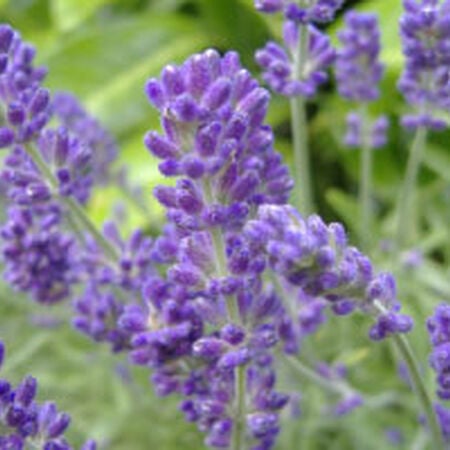English, Lavender Seeds
Key Attributes
Key Attributes
Product Details
Weight
0.008Depth
0.1Height
4.5Width
3.25Plant Height
18-30"Botanical Name
Lavandula angustifoliaSeed Type
SeedSeeds Per Gram
928Seeds Per Pound
420,800Packet
200 SeedsSow Depth
1/8"Seeds Per Ounce
26,300Breed
Open-pollinatedSun
Full SunGrowing Conditions
Container FriendlyLife Cycle
AnnualSow Method
TransplantCategories
HerbGermination
14,15,16,17,18,19,20,21Days To Maturity (# Days)
100Components
Growing Instructions
![]() Learning Download: How to Grow Lavender
Learning Download: How to Grow Lavender
The herb is said to cause relaxation and relieve stress. Lavender has blue-gray leaves and a very fragrant scent. Its stalks can be added to bouquets. In addition to its beautiful appearance and fragrant flowers, lavender also attracts pollinators to the garden. Many gardeners use lavender as an edging plant along borders or walkways.
Before Planting: Lavender should be planted outside after the last spring frost. You can also begin lavender inside and once the plants have their first set of leaves, transplant them to their final spot outdoors. However, if beginning inside, use a vermiculite mix instead of traditional potting mix to allow for better drainage.
Planting: When transplanting, space plants 12 inches apart in rows set 12 inches apart. Lavender also can grow in containers. If growing in a container, use a porous soil and don’t over-water.
Watering: Lavender thrives in hot weather, so be careful not to over-water as sodden soil can damage the plants.
Fertilizer: Lavender plants typically grow best in soil with poor nutrients. Over-fertilizing the plant can cause an excess in leaves and limited fragrant flowers. A more natural way to fertilize lavender is by placing an inch of compost around the plant. Do not fertilize the plant in the fall, as this will encourage new growth that will then be killed by the winter months.
Days to Maturity: Once the herb begins to bloom, remove the faded flowers to encourage more growth. Lavender is a perennial in some zones, so cut the dead branches back in the spring to prepare for the new season. (See each variety for days to maturity)
Harvesting: If using lavender as a bouquet, harvest it before the buds have fully opened. Partially closed buds will keep their scent and color longer.
Tips: Add sand or limestone gravel to a bed to improve its drainage or plant the lavender in raised beds.
Shipping Schedule
Our Seed Promise
 "Agriculture and seeds" provide the basis upon which our lives depend. We must protect this foundation as a safe and genetically stable source for future generations. For the benefit of all farmers, gardeners and consumers who want an alternative, we pledge that we do not knowingly buy or sell genetically engineered seeds or plants.
"Agriculture and seeds" provide the basis upon which our lives depend. We must protect this foundation as a safe and genetically stable source for future generations. For the benefit of all farmers, gardeners and consumers who want an alternative, we pledge that we do not knowingly buy or sell genetically engineered seeds or plants.
The mechanical transfer of genetic material outside of natural reproductive methods and between genera, families or kingdoms, poses great biological risks as well as economic, political, and cultural threats. We feel that genetically engineered varieties have been insufficiently tested prior to public release. More research and testing is necessary to further assess the potential risks of genetically engineered seeds. Further, we wish to support agricultural progress that leads to healthier soils, to genetically diverse agricultural ecosystems, and ultimately to healthy people and communities.
To learn more about the "Safe Seed Pledge" please visit www.councilforresponsiblegenetics.org.

